The Queens Guards
7 /10 1 Votes
Director Michael Powell Music director Brian Easdale Country United Kingdom | 6.8/10 IMDb Genre Drama Duration Language English | |||||||||||||||||||||||||||||||||
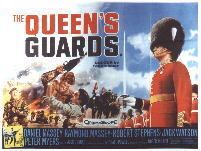 | ||||||||||||||||||||||||||||||||||
Release date 17 October 1961 (UK) Writer Simon Harcourt-Smith, Roger Milner Initial release October 17, 1961 (United Kingdom) Screenplay Simon Harcourt-Smith, Roger Milner Cast Daniel Massey , Robert Stephens , Raymond Massey , Ursula Jeans Similar movies Related Michael Powell movies | ||||||||||||||||||||||||||||||||||
A London guardsman (Daniel Massey) recalls his days at Sandhurst, his father (Raymond Massey) and his glory in battle.
Contents
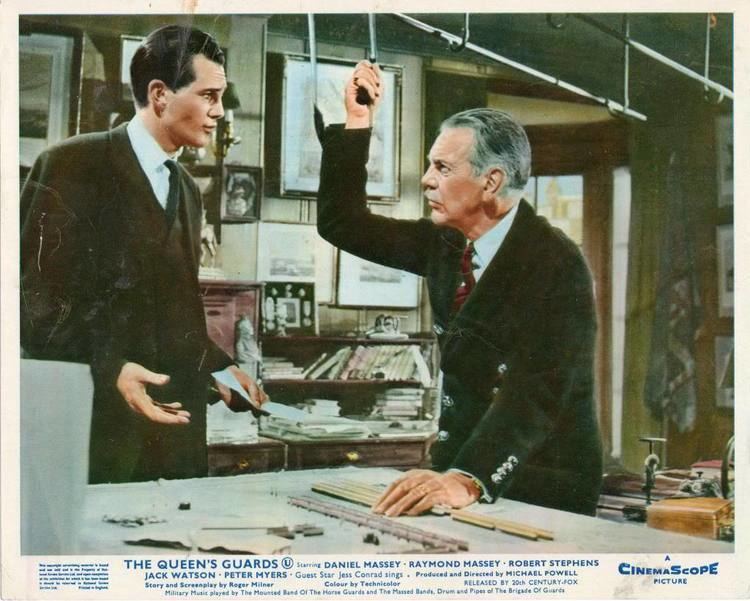
The Queens Guards is a 1961 military drama film directed by Michael Powell from a script by Simon Harcourt-Smith and Roger Milner. It stars Daniel Massey, Raymond Massey, Robert Stephens, and Ursula Jeans.
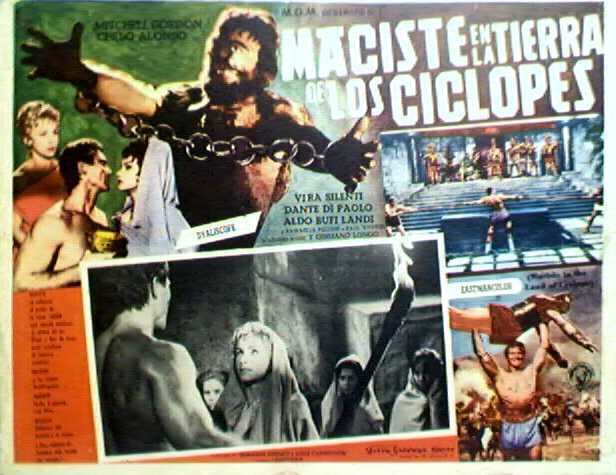
Captains John Fellows and Henry Wynne-Walton finish their Army training at Sandhurst Military Academy and are sent to the Middle-East. John is to lead a parachute battalion while Henry is put in charge of a platoon of armoured cars of the Household Cavalry. John is constantly being told by his father, an ex-Guards officer that he is not as good as his brother who was killed during the war.
Plot
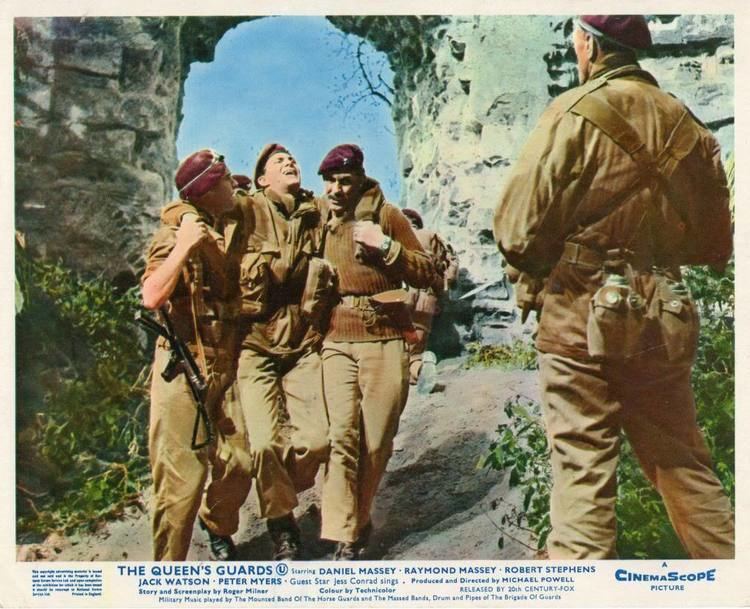
The film tells the story of John Fellowes (Daniel Massey), an officer in the Grenadier Guards as he prepares for the Trooping the Colour ceremony. John is the son of retired guardsman Capt. Fellowes (Raymond Massey) and Mrs. Fellowes (Ursula Jeans). Johns older brother was also a Guards officer, but he was killed in action and John feels he is being forced to follow in his brothers footsteps.
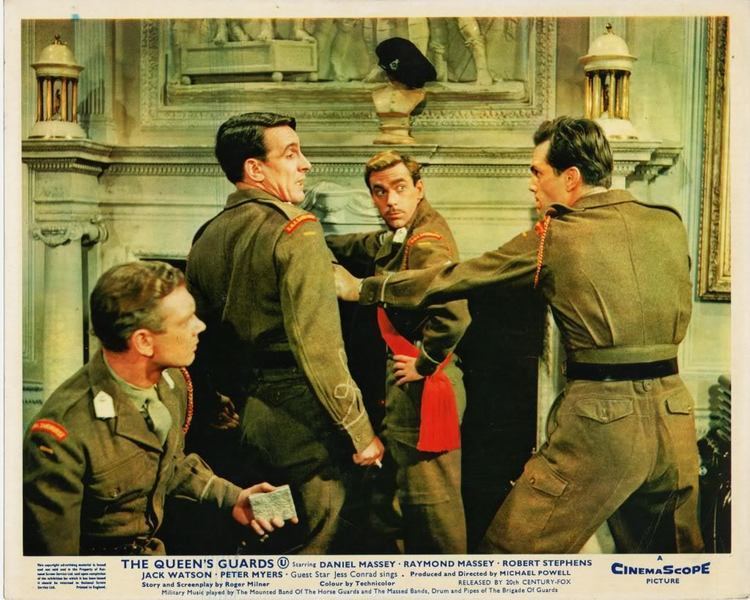
The film follows John through his training where he makes some mistakes in an exercise and is told that it was a mistake like that which got his brother and a lot of his men killed. But he makes friends with Henry Wynne-Walton (Robert Stephens) and Henry is invited home to meet Mr. and Mrs. Fellowes. Mr. Fellowes is quite fanatical about the Guards. The eldest son in the family has been a Guards officer for as long as anyone can remember, and they even live next door to the Guards barracks in London.
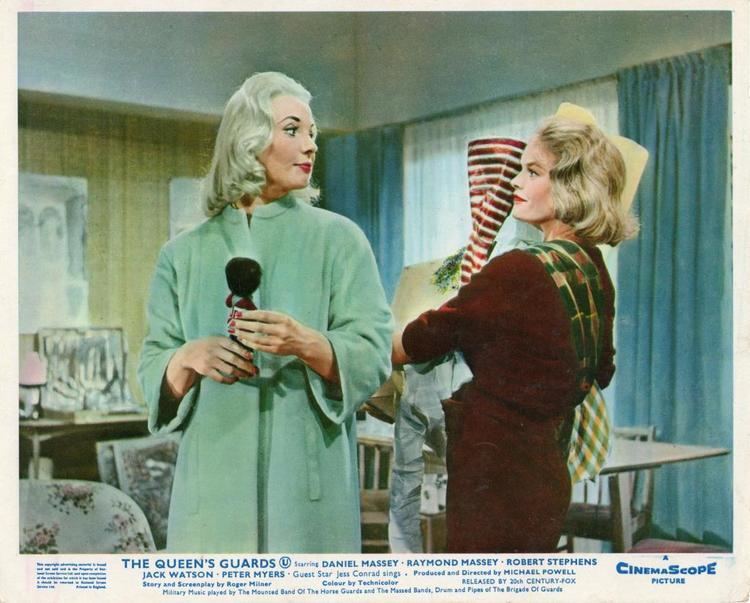
Capt. Fellowes is disabled, his legs dont work and he hauls himself around the house by hooking canes into loops on an overhead rail. This system was designed by the elder brother that John is always expected to live up to. His mother thinks that the elder brother is just "missing in action" and will return someday. The father knows hes really dead but never seems to give John a chance.
John is dating Ruth (Judith Stott), the daughter of George Dobbie (Ian Hunter), a haulage contractor. When John goes to see Mr. Dobbie he tells John that he was fighting in the desert and was let down by a platoon of Guards that were meant to hold a certain position – the platoon that was led by Johns brother.
John leads an assault on a desert fortress held by some rebels. To constant thoughts about how his brother died, John manages to defend against a counter-attack until Henry arrives with his men in their armoured scout vehicles. The mission is a success. John has managed to do what his elder brother could not.
Back in London, all is in readiness for the Trooping the Colour ceremony. Mr. Dobbie overcomes his dislike of the Guards to accompany Ruth to the ceremony. Capt. Fellowes manages to haul himself upstairs to see the ceremony out of the window. John is given the honour of commanding the colour party.
Cast
Cast notes
Production
The Queens Guards was made after Michael Powell had made Peeping Tom but before it was released. When Peeping Tom was released there was such an outcry that Powell never managed to direct another feature film in Britain.
Though released as "A CinemaScope Picture" with a CinemaScope credit at the beginning of the film, The Queens Guards was filmed in Technirama. 35mm Technirama release prints were compatible with CinemaScope release prints.
The intention of this film appears to have been to promote the Guards regiment in some way. Powell was certainly given access to the Guards barracks and to their training areas on Salisbury Plain. He was given permission to include many sequences of real guardsmen at the Trooping of the Colour But the production, especially the plot, is very scrappy with many details left unexplained
The Guards and The Colours
The soldiers in the red uniforms with the Bearskins (not Busbys) and the ones on horseback outside Buckingham Palace and at Horse Guards Parade (and on postcards from London) are members of the Regiments of Guards, originally the sovereigns own troops, and some of the oldest regiments in the British Army. They perform most of the ceremonial duties at state occasions, but they are not just "toy soldiers" intended only for public display. They are fighting regiments that also do ceremonial duties. One of the main aims of the film was to show this.
There are two mounted regiments of guards, the Life Guards and the Blues and Royals. There are five regiments of foot, the Grenadier Guards, the Coldstream Guards, the Scots, Welsh and Irish Guards. The mounted regiments can be differentiated by the colour of their uniforms (Life Guards – red, Blues & Royals – blue) and the regiments of foot by the arrangement of their buttons (and their cap badges and collar tabs if you get close enough). Grenadiers have evenly spaced buttons on the front of their tunics, Coldstream have buttons in pairs, Scots in threes, Irish in fours and Welsh in fives.
In their combat roles, the Guards are light armoured and reconnaissance troops. In A Bridge Too Far, Michael Caine lead a squadron of Irish Guards to spearhead the ground-based push towards Arnhem.
The ceremony of "Trooping the Colour" dates back to the distant past. "The Colour" is the regimental flag with all their battle honours on it. So that they could properly recognise and thus know which side they were on and where they should rally, the Colour would be paraded (trooped) in front of the regiment in a special parade before a battle. This was then turned into a ceremony. Because of the importance attached to the Colour, it is considered a great honour to be the soldier actually carrying it (the ensign), one of the Colour party protecting it, or to be in charge of the Colour party.
Reception
The Queens Guards almost entirely disappeared after its initial release. Contemporary reviews of it were not kind, and it had only a short run in cinemas, and was shown on British television just once.
References
The Queens Guards WikipediaThe Queens Guards IMDb The Queens Guards themoviedb.org
